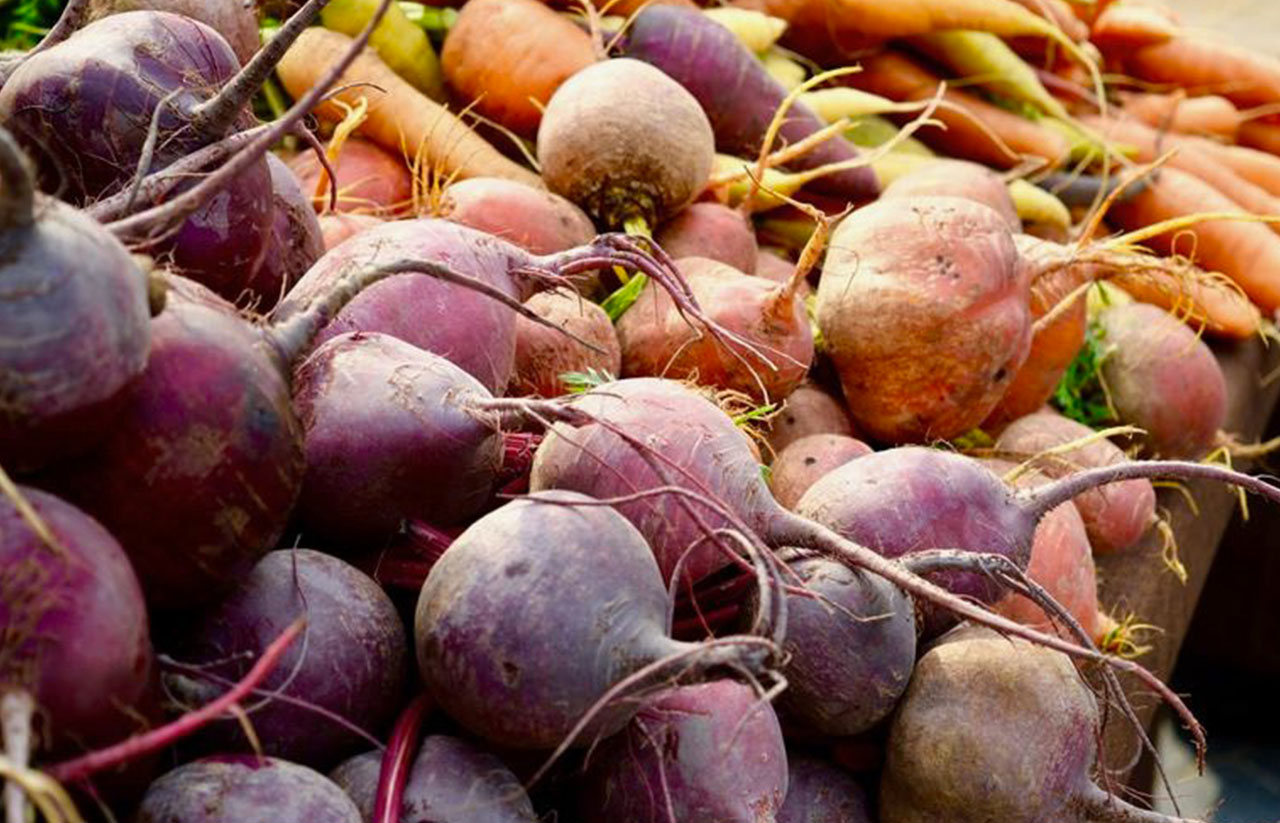Fall is a time of abundance.
This is obvious in markets where the seasonal produce is like a colorful painting, not unlike the turning of the trees in autumn months. Is this nature’s wisdom to attract us to the seasonal offerings? The seasonal produce has the nutrients that we need the most at this time of the year, as humans evolved in nature and our bodies needed to be in sync with what nature provided us. Root vegetables, winter squash and cole crops help our bodies prepare for the winter of less activity and cold weather. (“Cole crops” is a term used to describe certain leafy vegetables in the mustard family, including broccoli, Brussels sprouts, cabbage, cauliflower, collards, kale, and kohlrabi.) These crops are very grounding and warming as well as chock-full of immune boosting vitamins and minerals. In addition, these foods, if eaten in great quantities, can stimulate our bodies to produce fat storage hormones that eventually manufacture a layer of stored fat that insulates us from the cold and provides us the energy to make it through the winter. This was vital for our not-so-distant ancestors, who didn’t have the comforts we take for granted.
Although most of us have the luxury of keeping warm in our homes and have access to an unlimited variety of foods of all sorts and seasons all year long, our bodies are still evolutionarily programmed to react as they needed to for millions of years. In other words, gaining weight in the fall for the history of humankind was a normal and essential part of surviving winter. This may explain why cravings and urges to binge increase in the fall and winter, especially for sweet foods. Our attraction to the brightly colored fall foods and our addiction to carbohydrates is part of our DNA.
That doesn’t mean we have to gain weight and extra fat this season.
We also have the luxury, in these modern times, to eat in moderation and exercise with modern equipment and with especially warm clothing.
Another amazing thing about how our bodies adapt to seasons is the microbiome. In Dr. John Doulliard’s book, Eat Wheat, he cites research that shows how the starch-digesting enzyme, amylase, naturally increases in the body during the fall and winter. This is a time when starchy tubers, wheat grasses and grains are in abundance and harvested. This same enzyme decreases in the summer when our diets shift to less starch food and more leafy greens and fruits. In other words, gluten sensitivities may not be a permanent situation for some people. Perhaps, by being in sync (and practicing moderation), digesting wheat and other gluten foods may be more easily digested in the later fall and winter when your amylase enzymes are at their peak. As health coaches, it’s our job to uncover research about things like this and encourage you to experiment.
A significant component of leading a healthier lifestyle is understanding and being in touch with your body and how it works. Deconstructing your cravings, knowing it’s a part of your DNA programming, can help you make better choices. Of course you want something sweet. And though we may want the concentrated, easy access sugars of our modern world, give your body what it was designed to process: sweet foods like carrots, sweet potatoes and squashes. We can train our brains to readapt to these flavors and milder sweetness with a little patience and exploration. In the long run, it’s so worth the result of feeling better, providing our bodies with the nutrients they need, and avoiding dis-ease.
Part of the equation of readapting your tastebuds, of course, is learning how to make these delicious offerings which is a big component of our coaching sessions with clients. We encourage you to break out those cookbooks or online sites that provide real, whole food recipes (see some of our suggestions below). Also, here are a couple of our favorites.
Here is a basic, but delicious, root vegetable recipe followed by a fall vegetable recipe that you may not have heard of before and we encourage you to give it a try.
Basic Roasted Root Vegetables
What’s beautiful about this recipe is you can grab any single or combination of these root vegetables and roast them together. You can also mix up the spices you like. Experimenting with something you haven’t tried before (like rutabagas for example), alongside something you are familiar with (like potatoes), can be a nice way to play with flavors.
- Sweeter flavored root vegetables include: carrots, sweet potatoes, parsnips, beets, winter squash
- Stronger flavored root vegetables include: turnips, rutabagas
- Herbs we like this time of year: rosemary, thyme, parsley, oregano
NOTES: In this recipe, we’ve added roasted garlic sauce as an option to really give this dish a packed flavor. We also don’t always peel our vegetables as it adds both texture and fiber to the dish – but you can if you want. Some do need it – like winter squash and rutabagas and sometimes beets. If you love onions, add quartered onions about 10-15 minutes into the roasting time as they cook faster than the root veggies.
- 6-8 cups root vegetables, cut into 1-inch pieces
- 2 tablespoons extra virgin olive oil
- 1 tablespoon dried herbs OR 3 tablespoons fresh herbs, chopped
- Salt and pepper to taste
Toss everything together and spread onto a baking pan – ideally in a single layer.
Roast at 425 degrees for 30-45 minutes. Use a fork to test at 30 minutes for tenderness.
Roasted Garlic Sauce
- Roasted garlic bulb*
- 1 cup plain yogurt
Squeeze the soft, roasted garlic cloves into a bowl and mix with the yogurt.
*To roast the garlic: Take a whole bulb and remove the outermost loose papery layer – but do not peel. Slice off the top of the bulb. Nest it in a square of parchment or aluminum foil. Drizzle with olive oil and salt and pepper if you wish. Roast the garlic in the pan with the veggies.
Burdock (Gobo)
If you’ve never tried (or heard of) burdock root (also called gobo), it is worth the big bang of nutrients it provides. Burdock has a robust, meaty quality and is more chewy and fibrous than most other root vegetables. Because of this, braising is probably the best way to cook burdock. Boiling it eliminates too much of its flavor and roasting doesn’t soften it enough. Cutting it in smaller pieces and braising is relatively easy.
Burdock is the root of a thistle plant related to artichokes. It has an earthy, sweet flavor and is very popular in Japanese cuisine. It’s often braised with other root vegetables such as carrots, parsnips, beets, and turnips. When buying, look for dirt-coated pieces (which keeps them fresh) that are firm and no more than an inch thick. To prepare (and we suggest you prepare it as soon as possible as opposed to storing it for a few days), wash the dirt off the root. Peeling is not necessary as the burdock peel tastes sweet and robust. Trim the ends and slice or shred as you like. Note: raw burdock discolors very quickly when cut. To minimize darkening, rub cut burdock with lemon or dip in water with a couple of tablespoons of lemon juice.
This recipe is adapted from the blog Funky Foods.
Braised Burdock, Beet, & Carrot with Garlic
SERVES: 2
- 1 small burdock root (4 ounces)
- 1 small golden beet (4 ounces)
- 1 small carrot (2 ounces)
- 1 tablespoon unsalted butter
- 2 garlic cloves, minced
- 1½ cups stock of choice
- 3 tablespoons white wine
- 1 tablespoon honey or maple syrup
- Salt & black pepper, to taste
- Fresh minced parsley, for garnish
Brush and wash the burdock root under cold running water. Thinly slice it on a diagonal so that each piece is 2 inches long. Then collect some slices and cut them into thin strips. Place the burdock strips in a bowl of lemon water to prevent browning. Wash and peel the beet and carrot. Cut them into thin strips.
In a skillet, melt the butter over medium heat. Drain the burdock and add to the skillet and cook for 2-3 minutes. Then stir in beets and carrots. Add the garlic and sauté until fragrant.
Add stock, white wine, honey or maple syrup, salt, and pepper. The vegetables should be completely submerged; add more wine and stock if necessary. Simmer on low heat until the liquid evaporates, about 15 – 20 minutes. Taste and add more salt to taste. Garnish with chopped fresh parsley.
If you liked these recipes ideas, here are a few more for fall:
Tandoori Butternut Squash Soup




2 thoughts on “Why eating seasonally this fall is so important”
Thank so much for the recipe credit : )
Our pleasure. So glad we found you.